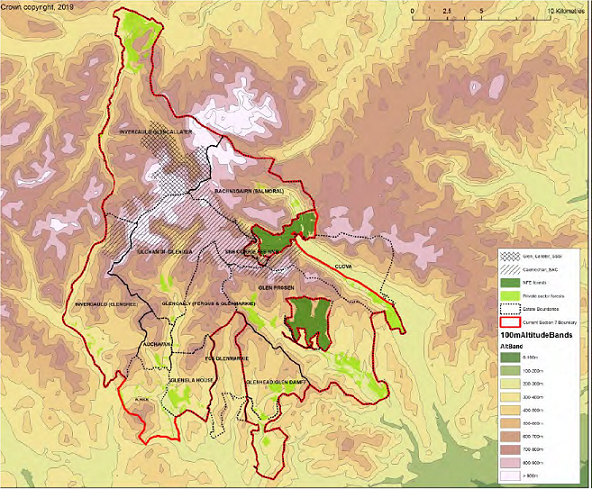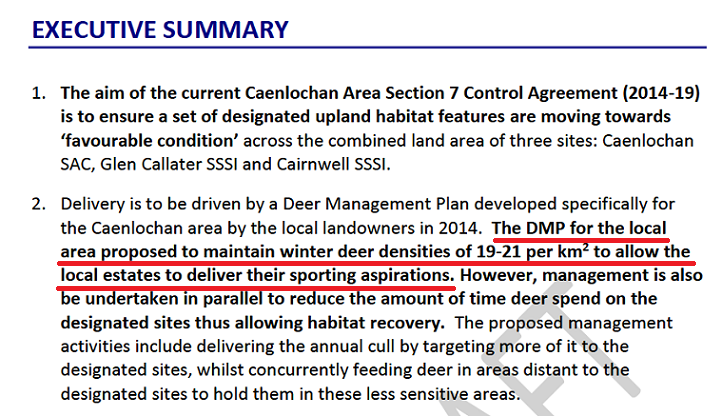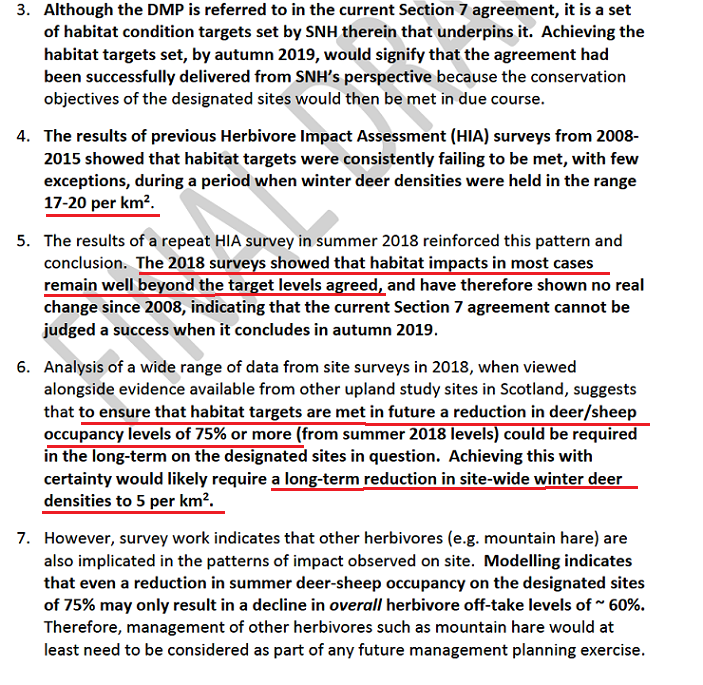For the last few years the Herald has carried a full page feature about once a week on the climate emergency and nature crises. Every 4-6 weeks this involves NatureScot, the new brand name for what is legally still Scottish Natural Heritage (SNH). Sometimes these pieces are written by NatureScot – often under the name of their Chief Executive Francesca Osawska (see here for an example) – and sometimes as a “sponsored article”, as on 29th December (see here). These articles are usually notable for their spin and what they don’t say and December’s provided a prime example. Here are the first three paragraphs:
“Scotland’s climate may be in crisis, but the rate of loss of its biodiversity is also alarming. Over the last 30 years, wildlife abundance has declined by almost a quarter. Our country is now one of the most wildlife depleted in the world – we sit in the bottom quarter of nations for biodiversity.
Reversing this decline is a huge challenge but it is one we simply cannot ignore.
Both the climate and biodiversity emergencies are now being tackled robustly and at pace: there cannot be any further delay if the country is to meet its net zero target of 2045.”
Scottish Natural Heritage was created in 1992 from the Nature Conservancy and Countryside Commission for Scotland, with a mission to protect nature and landscape as well as promoting outdoor recreation. The collapse in nature over the last 30 years has therefore taken place on its watch and if any agency could and should have prevented this disaster it was SNH. Instead of admitting its failures and analysing the reasons for this, the current leadership of SNH has rebranded itself in an apparent attempt to fool people into assuming it bears no responsibility for what has gone wrong.
The commitment to halt (not reverse) this disastrous collapse in nature by 2030 means another seven years of decline, hardly an indication that SNH is tackling the biodiversity crisis “robustly and at pace”. World War II was lost and won in a shorter period of time.
Following the entry of Green MSPs into the Scottish Government, SNH was handed responsibility for developing proposals for a new National Park in Scotland. In its consultation at the end of last year (see here), nothing was said about the role it has played in Scotland’s existing National Parks. In my response I suggested (as a former board member) that before SNH produces any new proposals for National Parks some critical self-reflection and acknowledgement of past mistakes would be in order.
The rest of this approach illustrates the need for this by considering NatureScot’s approach to the management of red deer at Caenlochan in the Cairngorms National Park.
NatureScot and deer numbers in the Cairngorms National Park
In 2010 the Deer Commission for Scotland was merged with SNH which assumed legal responsibility for their control. In theory, this put SNH in a very good position to start reducing the population of deer, increasing numbers of which have probably been the single most important factor in the collapse of biodiversity in Scotland.
In practice, however, SNH’s leadership did very little – it was the subject of much criticism in the report of the Deer Working Group (see here) – and generally endorsed excessively high numbers of deer, even on land like the Isle of Rum which it owned (see here). In the Cairngorms, I have obtained evidence which shows that by its actions it has actively undermined the Cairngorms National Park Authority (CNPA)’s attempt to reduce deer numbers.
In its latest National Park Partnership Plan the CNPA has set targets for deer density, an average of six deer per square km across the National Park and a maximum of ten. While the previous National Park Partnership Plan 2017-22 contained no target as such, it did say this:
“But the scale and connectivity of habitats and designated sites in the National Park requires a collaborative effort across the whole Park to maintain deer numbers at a level which enables delivery of the public interest priorities and reduces marked differences across land management boundaries. Where habitat enhancement is restricted by management objectives which seek to maintain higher red deer densities significantly above ten per km2, our aim is for the density of deer to be reduced.”
This was a considerable advance on the 2012-17 plan which said nothing about deer numbers: as one of the partners to the plan and the body with statutory responsibility for red deer, one might have expected SNH to be fully behind this.
SNH’s record at “Caenlochan”

Caenlochan is a small glen at the head of Glen Isla and to the west of Glas Maol which used to be at the centre of the former National Nature Reserve of that name. That wider area was then designated a Special Area of Conservation, which is supposed to afford sites the highest degree of protection. The nature conservation interest at Caenlochan, however, has been in unfavourable condition for many years due to the high numbers of red deer. As a consequence SNH in 2003 entered a voluntary agreement under Section 7 of the Deer (Scotland) Act 1996 to control deer numbers there.
The Report of the Deer Working Group, which was published in February 2020 (see here), was highly critical about what the various Section 7 agreements at Caenlochan, which had been in place at since 2003, had achieved and recommended the Scottish Parliament instigate an inquiry into what had gone wrong. That has still not happened but a Freedom of Information request which I submitted last year revealed SNH had quietly allowed the Section 7 to lapse in June 2020, just four months after the Working Group’s report appeared.
As a result of that FOI I also obtained a copy of a draft report which had been produced by the Strath Caulidh consultancy reviewing progress on the Caenlochan Section 7 Agreement since 2003 and hundred of pages of correspondence etc with the South Grampian Deer Management Group which covers the area. I also established that “NatureScot does not hold any information relating to individual estate deer management plans”. Their absence will have made it even harder for frontline staff to do anything meaningful
As far as I am aware, SNH has never published the final version of the Strathcaulidh report but the draft – at 25 MB its sadly too big to share here – is absolutely damning and brings a welcome focus to the need to tackle deer density at Caenlochan:

How SNH ever agreed to this number of deer at Caenlochan deserves a public explanation. SNH knew from the experience at Glen Feshie and Mar Lodge, where they granted licenses to shoot deer at night and out of season to reduce numbers, that to allow the natural environment to regenerate deer density needed to be reduced to below 5 per square kilometre. But several years later they were prepared to allow landowners at Caenlochan, which included Balmoral, to retain densities of c19-21 per square kilometre in winter.
It is little wonder the Deer Working Group called for a parliamentary inquiry into what had happened at Caenlochan and recommended:
“that Scottish Natural Heritage should adopt 10 red deer per square kilometre as an upper limit for acceptable densities of red deer over large areas of open range in the Highlands, and review that figure from time to time in the light of developments in public policies, including climate change measures.”
There is nothing in the Strathcaulidh report to indicate that SNH attempted to change the targets for Caenlochan after the CNPA adopted their the aim to reduce deer numbers when they were more than 10 per square km. The Executive Summary in the Strathcaulidh report does, however, summarise the history of this failure and also show that actual grazing levels at Caenlochan were even higher than the target target:

Paragraph 6 rightly suggests deer density should be reduced to 5 per square kilometre. This is merely what SNH should have known from what had happened at Glen Feshie over 12 years before. In my view it is not SNH staff on the ground who should be blamed for this failure – the FOI response includes some “frustrated” email correspondence – but the people at the top, the SNH senior management team and board who were happy to go along with what should have been unacceptable.
Whatever the terms of Section Agreement in 2014 (I failed to ask for a copy) could still have acted before it expired in 2019. For example, SNH’s report on expenditure over £25k (see here), shows it paid Invercauld Estate, the area with perhaps the highest grazing pressure in the whole of the Caenlochan area, over £120k in grant in April 2019:
SNH could have withdrawn that grant and funding to all other estates in the Deer Management Group, including Balmoral, and used that as a lever to negotiate lower targets. They failed to do so and the public, through SNH, was left subsidising landowners who have been responsible for extraordinary levels of damage to the natural environment. King Charles is known to stalk on Invercauld and I have been told, but unable to verify, that the Royal Family may hold the sporting lease for Glen Callater and environs. Until SNH is prepared to tackle the Royal Family about deer numbers on Balmoral and the other areas they stalk, nothing significant will change.
Even if the terms of the Section 7 agreement made it impossible to revise it before it lapsed, SNH could have taken action in June 2020 or converted the Section 7 Agreement into a compulsory Section 8 agreement which required the estates in the South Grampian Deer Management Group to reduce deer densities to a maximum of ten, as provided for in the CNPA plan. Instead, SNH just let the agreement lapse.
Two years later, in June 2022, the South Grampian Deer Management Group made an unprecedented call to SNH to put a Section 7 Agreement back in place (see here). The independent chair of the South Grampian Deer Management Group, Doug McAdam, was the former Chief Executive of Scottish Land and Estates and a member of the Cairngorms National Park Authority Board, and was quoted as follows:
“Red deer numbers in the area from a recent count in March 2022 sit at around 6,974, down nearly 24% from a population of 9,135 in January 2019. This represents the result of sustained culling in the area over the last four years but, for the Group to achieve what is required and deliver for both the public and private interest, more needs to be done and deer numbers will have to be reduced further……………..
“To achieve this all estates in the Group area need to play their part and fulfill their deer management obligations and responsibilities. Deer management across a large area, with a highly mobile deer population crossing multiple landholdings will only work if all landholdings across the area cooperate and work collaboratively with their neighbours to manage deer aligned to common objectives.”
The cull, though not before time, was most welcome. But it said something about the depths to which environmental protection in Scotland had sunk that landowners with some of the highest numbers of red deer in Scotland felt compelled to call on NatureScot to take action.
What next for NatureScot?
While it remains unclear what action, if any, SNH intends to take as a result of that call from Caenlochan, in mid-January they issued a news release (see here), supported by the local Deer Management Group, about how hey were using their powers to cull deer at the Loch Choire Estate in East Sutherland. An article in the Herald (see here) contained the following very interesting statement (not contained in the news release):
“Culls are based on target density per square kilometre. NatureScot undertook a helicopter count of the Loch Choire Estate and surrounding ground in November last year.
This returned a density estimate of 13 deer per km2 for Loch Choire Estate and 12.9 deer per km2 for the overall area counted – with the target being 7.5.”
This intervention appears to be very welcome change in direction. But with SNH now taking compulsory action against an estate where deer are 13 per square, why have they not stepped in and taking action against the recalcitrant estates at Caenlochan and any others that fail to reduce deer to 5 per square kilometre, the maximum recommended by Strathcaulidh? Is it because the landowner at Loch Choire Estate appears to have disappeared without trace, making it easy to take action, whereas at Caenlochan SNH would, among others, have to take on Balmoral and King Charles?
Parkswatch has long argued that the single greatest thing which would make a difference to conservation in Scotland, both in terms of allowing nature to recover and in mitigating climate change, would be to reduce deer numbers, preferably to 2 per square kilometre or less (the second would be to ban muirburn). Generally, conservation organisations have been reluctant to argue this case in public, maybe because some don’t want to upset their royal patrons, while others are rightly fearful of the dark forces which attack anyone brave enough to speak the truth and could threaten their funding.
It was brilliant therefore to read a recent article (see here) from the John Muir Trust in response to attacks on their deer culls in Assynt. This clearly explained why deer numbers need to be reduced, why fencing is not appropriate and referred to the shadowy interests they are up against. It is highly recommended reading but contained one sentence with which I disagree:
“We are happy to be accountable for our land management by agencies whose role is to represent the public interest, whether that be NatureScot, the Scottish Land Commission or the Scottish Government.”
SNH/NatureScot has never represented the public interest on deer management since it assumed responsibility for it in 2010. Until SNH publicly acknowledge this – preferably in front of the Environment, Climate Change and Land Reform Committee of the Scottish Parliament – and their responsibility for Scotland’s excessively high deer numbers and the environmental disaster this is still causing, no-one should trust them. Their intervention at Loch Choire is an opportunity for the Scottish Minister responsible for SNH, the Green MSP Lorna Slater, to issue a clear statement about when SNH will now use their compulsory powers and commit to provide the funding to do so.
Taking compulsory action to reduce deer numbers around every designated site which has been identified as being in unfavourable condition due to overgrazing would be a start. Even reducing deer to say 5 per square kilometre would require significant resourcesbut this could be funded out of the £250m Peatland Action fund which SNH administer and at present is seriously underspent. There is no point restoring areas of exposed peat only for deer to trample over the vegetation and destroy it and the Scottish Government would be much better dealing with the source of the problem first. This would not stop peatland restoration continuing in the few areas where deer numbers are very low.
Surely it is obvious to everyone why Scottish Natural Heritage/Nature Scot have repeatedly failed, over decades, to use their statutory powers to reduce red deer numbers on Balmoral and other estates in the Caenlochan area – too many of their Board members and senior staff have been waiting to see their names appear in the Queen’s/King’s Honours Lists over many years. Knighthoods and low deer densities do not go together. Maybe some integrity will be restored to SNH/NS later this year when the Scottish Government appoints a new chair to lead this continuously failing public body.
I think Dave hits the nail on the head, here. Royal patronage is a pernicious and corrupting force which retards progress in many areas, not least in Nature Conservation, where responsible bodies and committees of oversight are too often stuffed with the ‘great and the good’ and other wannabes.
Think it’s more to do with the degree of political support from Government for action from SNH than an easy cynical ‘corruption’ trope tbh.
Bit more oomph from the Greens.
Section 7 of the report states that other herbivores such as mountain hares are implicated in having an effect on the impact observed on the site. Was this bit inserted under pressure from landowners so that they could then use the report as evidence against the Scottish Government’s plans (at the time) to stop the mass culling of mountain hares? Alternatively the number of hares might genuinely be too high due to a lack of natural predation. This wouldn’t be all that surprising as their main predator is the golden eagle and the Eastern Cairngorms, including Invercauld Estate, are a well known raptor persecution hotspot.